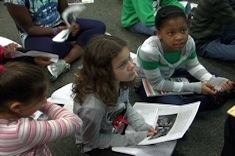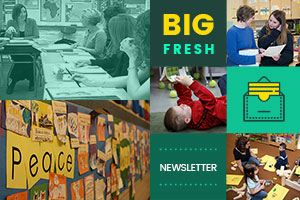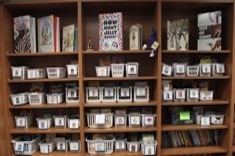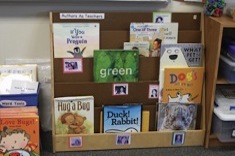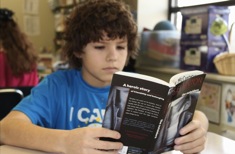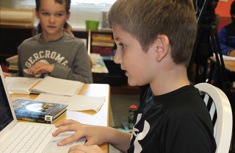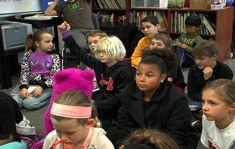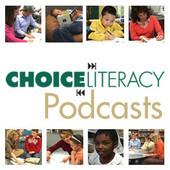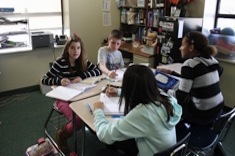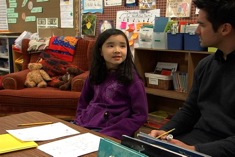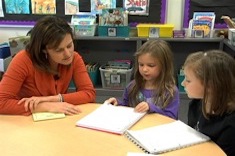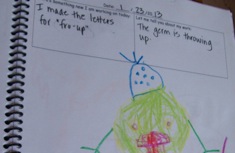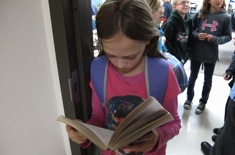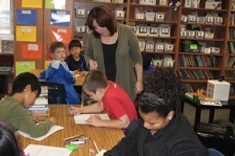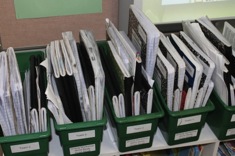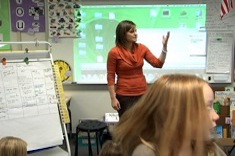Library
Choice Literacy Articles & Videos
The Choice Literacy library contains over 3,000 articles and 900 videos from 150+ contributors. Classic Classroom and Literacy Leadership subscribers have access to the entire library. Content is updated continuously, with five to six new features published each week.
Latest Content
Chris Lehman and Kate Roberts on Close Reading (PODCAST)
Franki Sibberson chats with Chris Lehman and Kate Roberts about close reading in this 30-minute podcast. Chris and Kate are the authors of Falling in Love with Close Reading: Lessons for Analyzing Texts — and Life from Heinemann.
Owl Research: Whole Class Explanation of Marking Up Text
Students are given a nonfiction text to mark up during a close reading with a partner in this video from Andrea Smith’s fourth-grade classroom.
The Big Fresh August 31, 2013 Chasing Joy
Setting goals for students and adults is the topic of this week's Big Fresh.
Conferring in 4th Grade: The Dilemma of Multiple Novels
Melissa Styger confers with a fourth-grade student who is reading two novels simultaneously, and shares her criteria for determining when it’s appropriate for students to read multiple texts.
Mentor Texts for Writing Endings
One goal of many primary teachers is to help students finish their drafts with an ending other than “The End” (or “they lived happily ever after”). Katie DiCesare shows her first graders many alternative examples, and she begins early in the year.
Literacy Contracts: Introduction
Megan Ginther and Holly Mueller present Reading Contracts, a system for middle and high school teachers that involves students contracting to complete specific texts and tasks each month.
The Cure for Value-Added Grief? Teacher Research
Gretchen Taylor goes through the stages of "value-added grief" when her sixth-grade team receives disappointing test scores from the state. Teacher research helps her find joy again in her classroom, as well as some useful strategies for helping a group of struggling readers.
Using Pinterest for Professional Development
Franki Sibberson finds Pinterest is a useful tool for professional development.
Helping Students Evaluate Online Video for Research
Even if your district is blocking web video now, it's not going anywhere. As time goes on, schools will rely more and more on video available from the Internet for research and learning. Bill Bass has practical advice for helping middle and high school students assess everything from suspect sources to appalling comments on the Wild Wild Web.
The Big Fresh August 24, 2013 Texting About Reading
Using tech resources to build a classroom reading and writing community is the topic of this week’s Big Fresh.
The Big Fresh August 17, 2013 Pausing Time
We consider book and wall displays in this week’s Big Fresh.
Using Technology to Connect Young Readers and Writers
Julie Johnson reflects on how technology is changing her own reading community, and builds on this knowledge to connect readers and writers in her classroom with others through the Internet.
Fourth Grade Writing Workshop Minilesson on Focusing
Franki Sibberson shares some tips and strategies with her fourth graders from the web for focusing and organizing their writing.
The Minimalist: Essential Texts for Kindergarten Teaching
Max Brand develops a "Swiss army knife" booklist of texts that he can't live without when teaching young learners.
Global Read Aloud with Pernille Ripp (PODCAST)
Franki Sibberson chats with Pernille Ripp about the Global Read Aloud initiative.
Laundry Line Luxuries
Suzy Kaback writes about the pleasures of slowing down and being inefficient sometimes in teaching and relationships.
Reimagining Reading Notebooks
When premade reading notebooks no longer fit into her reading budget, Katherine Sokolowski comes up with a unique design starting with generic notebooks, and in the process figures out what’s most important to include.
Building from Strengths: Conferring with Mia
Sean Moore confers with second grader Mia, gently encouraging her to work from her strengths by writing about what she knows well.
The Big Fresh August 10, 2013 Awkward Is Good
Planning and prioritizing assessments early in the year is the topic of this week’s Big Fresh.
Notebooks, Goals, and Writing About Characters in First Grade
Katie DiCesare confers with a group of first graders about their writing notebooks, goals, and drafts about the characters they are studying during reading workshop.
In Defense of Dictation
Leslie Woodhouse finds dictation is a critical tool for understanding young writers and their sense of story.
What Data Will You Be Collecting?
Tony Keefer explains why attitudinal survey data is important to collect early in the year, and shares different reading surveys he uses with students to understand their needs in the first six weeks of school.
Rethinking the Assessment Binder
Franki Sibberson’s dilemma? How to file every evaluation so it is organized and accessible (since she never knows when someone might ask for it), while still finding a way to keep the assessments she needs every day at her fingertips.
The Big Fresh August 3, 2013 What We Teach
Routines for independence is the focus of this week’s Big Fresh.
“My Ideal Bookshelf”: Books that Educate Us
Ellie Gilbert shares an activity that is a terrific way to get to know your new students. Although Ellie works with high school students, this activity can be adapted for the younger grades.
Routines to Build Independence Early in the School Year
Katie DiCesare explores how to develop routines early in the year, and includes advice to give to parents to build the home/school connection around expectations for independence.
Daily Routines: Finding Time for What Matters
Ann Marie Corgill provides some guiding questions to help teachers figure out priorities in their schedules for daily routines.
Transition Tool: “Come On Over”
This video is a quick take from Katie DiCesare’s first-grade classroom, showing how she uses the tune “Come On Over” as a transition tool.
The Big Fresh July 27, 2013 Growth and Choice
We have many takes on selecting first read alouds in this week’s Big Fresh.
First Read Alouds (ROUND-UP)
Choice Literacy contributors share their picks for the first read aloud of the year.
Browse Content By
Type
Category
- Assessment Tools
- Big Fresh Archives
- Booklists
- Choice Numeracy
- Classroom Design
- Common Core
- Community Building
- Conferring
- Content Literacy
- Digital Literacy
- English Language Learners
- Equity
- Family Relations
- Free Samples
- Guiding Groups
- Leadership
- Literacy Coaches
- Mentor Texts
- Minilessons
- New Teacher Mentors
- Podcasts
- Poetry
- Quote Collections
- Reading Strategies
- Self Care
- Struggling and Striving Learners
- Talking and Listening
- Teacher Study Groups
- Teaching Reading
- Teaching Writing
- Word Study and Vocabulary
Author
- Melissa Quimby
- Nawal Qarooni
- Gwen Blumberg
- Julie Cox
- The Lead Learners
- Hannah Tills
- Josie Stewart
- Ruth Metcalfe
- Mallory Messenger
- Becca Burk
- Jodie Bailey
- Vivian Chen
- Mary Brower
- Tiffany Abbott Fuller
- Stephanie Affinito
- Ruth Ayres
- Leigh Anne Eck
- Heather Fisher
- Shari Frost
- Julie Johnson
- Suzy Kaback
- Gigi McAllister
- Shirl McPhillips
- Melanie Meehan
- Cathy Mere
- Debbie Miller
- Tara Barnett and Kate Mills
- Tammy Mulligan
- Dana Murphy
- Bitsy Parks
- David Pittman
- Brenda Power
- Heather Rader
- Matt Renwick
- Mandy Robek
- Christy Rush-Levine
- Gretchen Schroeder
- Jen Schwanke
- Brian Sepe
- Katherine Sokolowski
- Stella Villalba
- Jennifer Vincent
Grade Level
Choice Literacy Membership
Articles
Get full access to all Choice Literacy article content
Videos
Get full access to all Choice Literacy video content
Courses
Access Choice Literacy course curriculum and training


